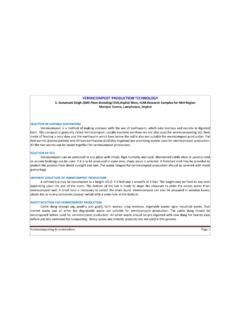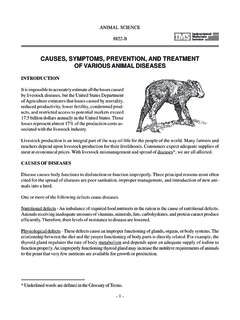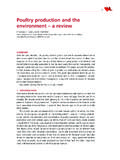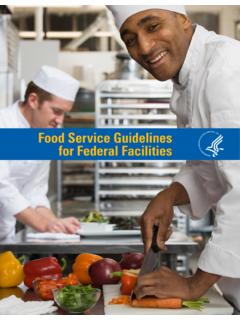Transcription of VACCINATION SCHEDULE POULTRY Dose Route
1 VACCINATION SCHEDULE POULTRY Layers Age Name of Vaccine Dose Route 5-7th day Lasota - I/R or I/O 14-16th day - I/O or D/W 24-26th day (booster) - D/W 30th day Lasota (booster) - D/W 7th week Fowl Pox ml. I/M 9th week Deworming - - 10th week R2B ml. I/M 15th week Debeaking - D/W 17th week Lasota - - Broilers. Age Name of Vaccine Dose Route 3-5th day Lasota - I/O or I/n 7-9th day - I/O or D/W 16-18th day (booster) - D/W 24-26th day Lasota (booster) - D/W Note : I/N Intra Nasal; I/O Intra Occular; D/W Drinking water; I/M Intra Muscular TREATMENT OF INTESTINAL WORMS VIA DRINKING WATER Active Ingredients Susceptible worms Problems and Drugs side Effects Piperazine Sulfate Roundworms only 1. Resistance has been associated with this drug. 2. Water soluble Levamisole Hydrochloride Roundworms, Capillaria, cecal 1. No effect on egg production or performance when used 8-16mg/lb body weight dose.
2 2. Water Soluble Albendazole Roundworms, Capillaria, cecal and tapeworms No reported negative effects Oxfendazole Roundworms, Capillaria, cecal Can settle in water lines Fenbendazole Roundworms, Capillaria, cecal Can settle in water lines Ivermectin Roundworms, Capillaria, Cecal Can settle in water lines Modern and well-established scientific practices should be used to obtain maximum economic benefits from POULTRY farming. Some of the major norms and recommended practices are given below : POULTRY Housing : 1. Select well raised land for POULTRY sheds. Land with hard rock or murram is more suitable. Avoid water logging and flooding near the sheds. 2. Ensure adequate facility for water, electricity, approach road, supply of chicks, feed, veterinary aid and nearness to market for sale of live birds and dressed chicken. 3. Obtain training/experience in broiler farming before starting a farm.
3 You should be prepared to stay on the farm and have constant supervision. 4. Provide adequate floor space, feeding space and watering space per bird 1. This is the most important basic principle in housing, as the space available determines the number and type of POULTRY that can be kept. For example, a deep litter house measuring 6 m by11 m can hold 200 laying hens at a stock density of 3 birds/m2 ( ft2/bird). Under the older system of measuring, stock density was measured in ft2 per bird, which is the inverse of birds per m2 used in the metric system, incorporating a conversion factor of m2/ft2. 2. Requirement of chickens for floor and perch space: 1. Layer 3 25 cm (10 in) 2. Dual Purpose 4 20 cm (8 in) 3. Meat 4-5 15-20 cm (6-8 in) 3. Watering of Birds : 1. Always give fresh and clean drinking water.
4 Water should be always available at birds. 2. Use properly designed watering equipment. Provide adequate watering space per bird. 3. Always keep water-pots clean. Avoid birds entering inside pots. 4. Provide cool water during summer. Store the water in tanks that are not exposed to hot sun in summer. 5. Construct sheds in such a way that the end walls face East-West direction and the sidewalls face North-South direction, so that rainwater will not enter the sheds. 6. Provide strong roof and hard flooring. Raise plinth of the shed at least one feet above the outside ground level. 7. Provide 3 to 4 feet overhang of the roof to avoid entry of rainwater inside the shed. 8. Provide adequate light and ventilation and comfortable housing conditions during all seasons (cool in summer and warm in winter). Construct sheds in such a way that predators (cats/dogs/snakes) will not enter the shed.
5 Avoid entry of rats by constructing rat proof civil structures. 9. Keep the shed clean and free from flies/mosquitoes etc. 10. After disposal of every batch of birds the dirty litter material and manure should be removed, walls and floors should be cleaned, white washed with lime and disinfected with malathion or DDT insecticide spray. 11. If deep litter system is followed, always use dry and clean litter material (sawdust, paddy husk, etc.). Spread 4" layer of litter on the floor, keep clean/disinfect brooding, feeding and watering equipment and then introduce chicks in the house. 12. The litter material should be always kept loose and dry. Stir the litter twice a week. Any wet litter/droppings etc. should be removed and replaced with fresh/clean dry litter. disease Prevention/Control : sanitary conditions of POULTRY sheds and equipment, balanced feed, fresh clean water, healthy chicks are essential to prevent diseases.
6 Entry of visitors to farm, especially inside the sheds. If visitors come, ask them to dip their feet in a disinfectant solution, wash and clean hands and to wear apron/boots provided by the farm. proper VACCINATION SCHEDULE high quality vaccines purchased from reputed manufacturers. Keep vaccines in cool, dry conditions away from sunlight. left-over vaccine should be properly disposed off. Vaccines should not be used after their expiry date is over. dead bird should be immediately removed from the shed and sent to laboratory for post-mortem or buried/burnt suitably away from the POULTRY sheds. waste of farm should be suitably disposed off. bird showing advanced signs of a disease , should be removed from the shed and culled. It can be sent to laboratory for diagnosis. showing advanced signs of a disease should be shown to a qualified veterinarian and suitable medication/treatment be given as per his/drug manufacturers recommendations.
7 Manure, if infected, can spread disease , from one batch to another. Keep the litter dry, remove it after flock is sold and dispose the manure properly and quickly. proper records on mortality and its causes and the treatment given to birds. Dates of VACCINATION for each flock should be properly recorded. are important carriers of POULTRY disease . Avoid rats. Use suitable rat poisons/rat traps. POULTRY medicines can be given in drinking water. When medication is to be given, remove the waterers in POULTRY sheds on the previous evening. Next morning give medicine in measured quantity of water, so that entire medicine will be quickly consumed and there will be no wastage of medicines. infection of disease may not cause mortality but it will reduce growth. Keep sample record of body weight and mortality rate. Study the possible causes, if weight is low take steps to improve the management of the subsequent batches.
8 A Constant vigil and analysis of records/results is necessary to keep up the efficiency in farming.





